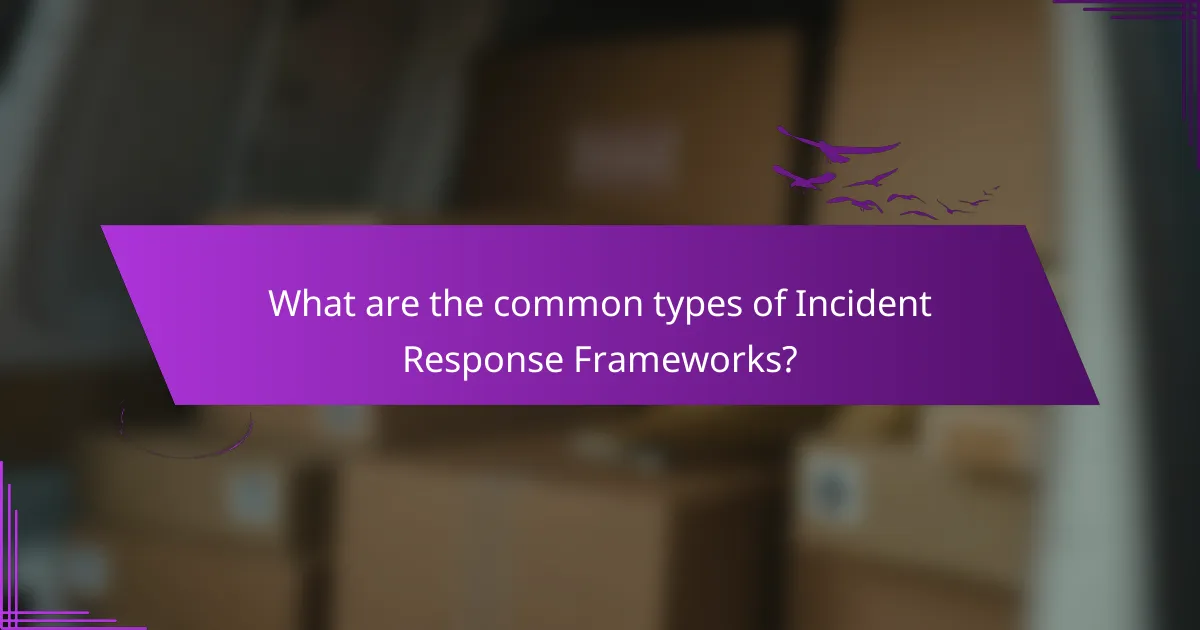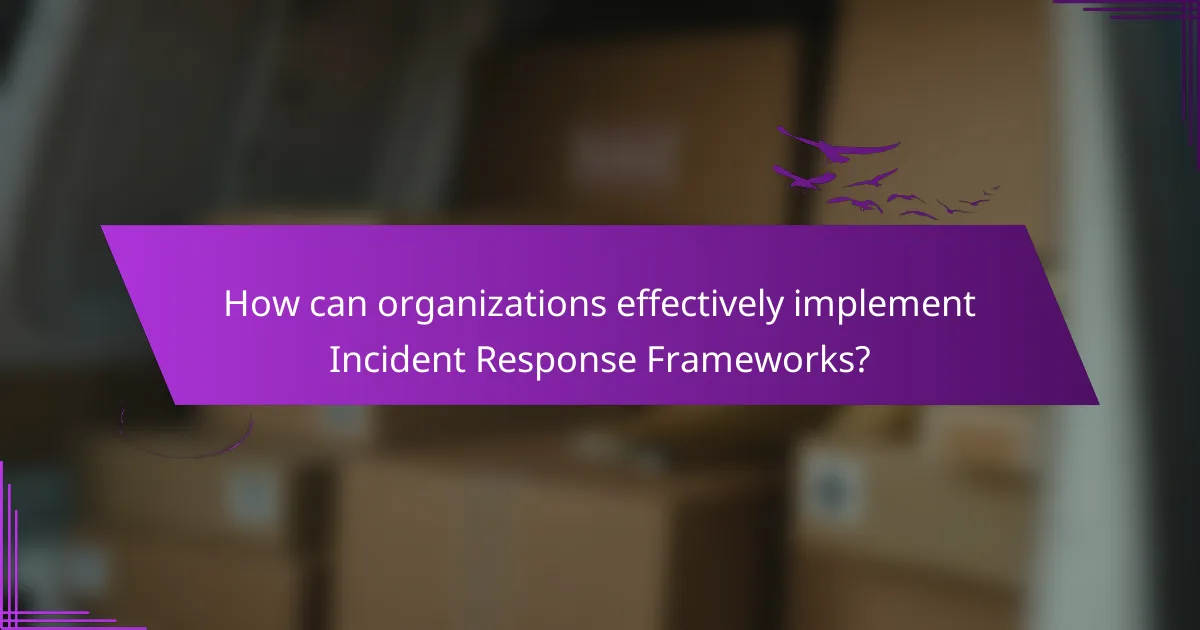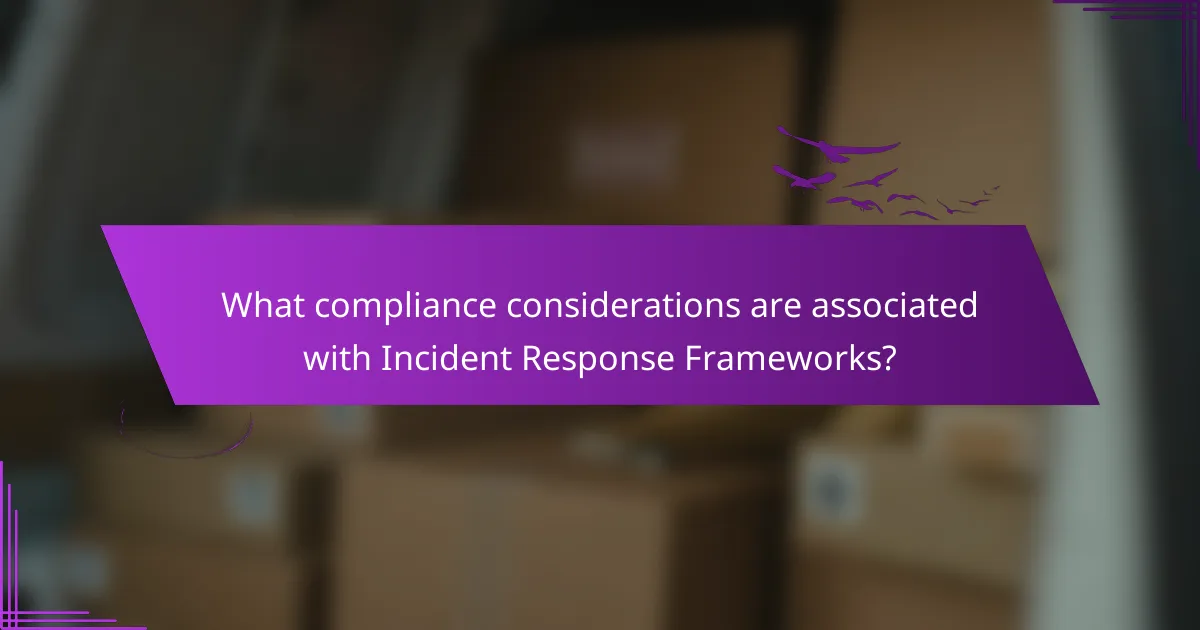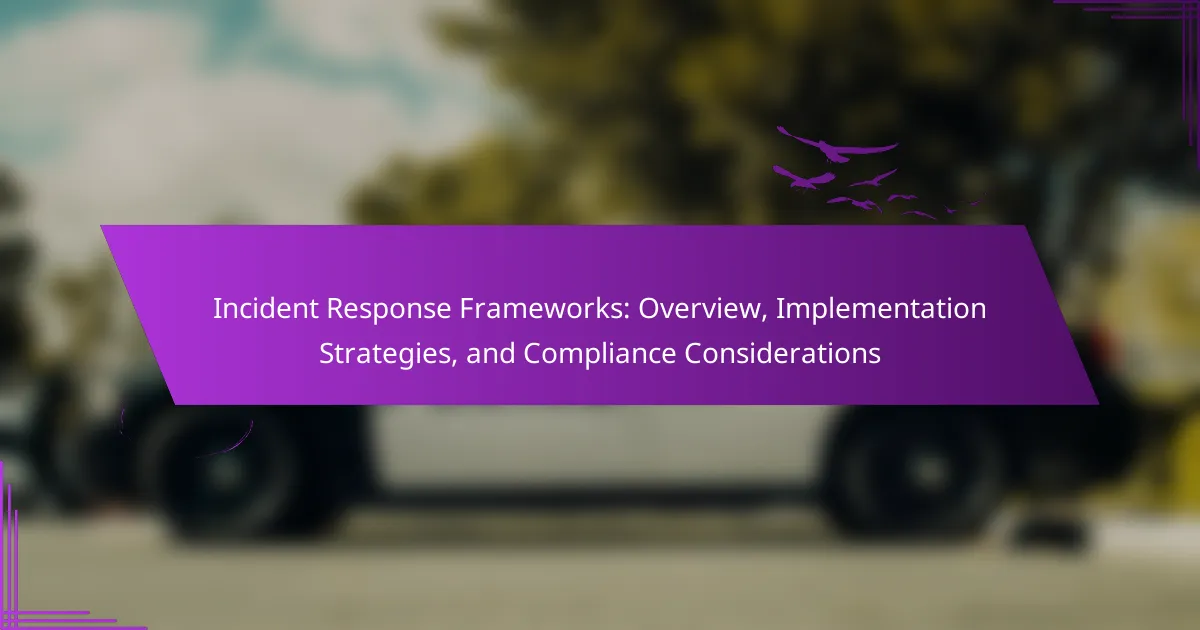
What are Incident Response Frameworks?
Incident response frameworks are structured approaches for managing cybersecurity incidents. They provide guidelines for organizations to effectively detect, respond to, and recover from security breaches. Common frameworks include NIST, SANS, and ISO/IEC standards. These frameworks outline phases such as preparation, detection, analysis, containment, eradication, recovery, and post-incident review. By following these phases, organizations can minimize damage and improve future responses. Research shows that organizations using incident response frameworks can reduce incident recovery time by up to 50%. This demonstrates the effectiveness of structured incident management in enhancing cybersecurity resilience.
How do Incident Response Frameworks function?
Incident Response Frameworks function by providing structured processes for managing and mitigating security incidents. These frameworks outline specific phases such as preparation, detection, analysis, containment, eradication, recovery, and post-incident review. Each phase has defined objectives and actions to ensure a comprehensive response to incidents. For instance, during the detection phase, monitoring tools identify potential threats, while the analysis phase assesses the impact and scope of the incident. The containment phase focuses on limiting damage, and eradication involves removing the threat from the environment. Recovery ensures systems are restored to normal operations. Lastly, the post-incident review phase evaluates the response effectiveness and identifies areas for improvement. These structured processes help organizations respond efficiently, minimize damage, and enhance future response efforts.
What are the key components of an Incident Response Framework?
The key components of an Incident Response Framework include preparation, detection and analysis, containment, eradication, recovery, and post-incident review. Preparation involves establishing policies, procedures, and training for incident response. Detection and analysis focus on identifying and understanding incidents through monitoring and investigation. Containment aims to limit the impact of the incident. Eradication involves removing the cause of the incident from the environment. Recovery focuses on restoring systems and services to normal operations. Post-incident review is crucial for evaluating the response and improving future practices. These components collectively ensure an effective response to security incidents.
How do these components interact during an incident?
During an incident, components of an incident response framework interact through a structured process. The framework includes preparation, detection, analysis, containment, eradication, recovery, and lessons learned. Each component relies on the others for effective incident management. For instance, detection triggers analysis, which informs containment strategies. Containment efforts are supported by recovery plans to restore systems. Communication among components ensures timely updates and coordinated actions. This interaction is essential for minimizing damage and restoring normal operations swiftly. The National Institute of Standards and Technology (NIST) emphasizes this interconnectedness in their Cybersecurity Framework, highlighting that effective incident response requires collaboration among all components.
Why are Incident Response Frameworks important?
Incident response frameworks are important because they provide structured guidelines for managing cybersecurity incidents. These frameworks help organizations respond quickly and effectively to minimize damage. They establish clear roles and responsibilities during an incident. This clarity aids in communication and coordination among team members. Research indicates that organizations with established frameworks can reduce incident recovery time by up to 50%. Additionally, frameworks support compliance with regulations like GDPR and HIPAA. Compliance can lead to reduced legal penalties and enhanced trust from customers. Overall, incident response frameworks enhance an organization’s resilience against cyber threats.
What benefits do organizations gain from implementing Incident Response Frameworks?
Organizations gain improved security posture from implementing Incident Response Frameworks. These frameworks enable structured responses to security incidents. They help minimize damage during an incident. Rapid detection and response reduce the impact on business operations. Effective frameworks also enhance compliance with regulatory requirements. They provide clear guidelines for incident management. This leads to reduced recovery time and costs associated with breaches. Additionally, implementing these frameworks fosters a culture of security awareness within the organization.
How do Incident Response Frameworks mitigate risks?
Incident Response Frameworks mitigate risks by providing structured approaches to identifying, managing, and recovering from security incidents. They establish clear protocols for detecting threats and responding effectively. This reduces the potential impact of incidents on an organization. Frameworks also facilitate communication among stakeholders during an incident. They help ensure compliance with regulatory requirements, which can prevent legal repercussions. By analyzing past incidents, these frameworks allow organizations to improve their defenses over time. Research shows that organizations with established incident response plans can reduce recovery time by up to 50%. Thus, Incident Response Frameworks are essential for minimizing risks associated with security breaches.

What are the common types of Incident Response Frameworks?
The common types of Incident Response Frameworks include the NIST Cybersecurity Framework, the SANS Incident Response Framework, and the OCTAVE Framework. The NIST Cybersecurity Framework provides guidelines for managing cybersecurity risk. It emphasizes the importance of preparation, detection, analysis, containment, eradication, and recovery. The SANS Incident Response Framework outlines a step-by-step approach for responding to incidents effectively. It focuses on preparation, identification, containment, eradication, recovery, and lessons learned. The OCTAVE Framework, developed by Carnegie Mellon University, emphasizes risk assessment and management. It guides organizations in identifying and managing security risks to their information assets. These frameworks are widely adopted due to their structured approaches and proven effectiveness in incident response.
How do different Incident Response Frameworks compare?
Different Incident Response Frameworks offer varying approaches to managing security incidents. The NIST Cybersecurity Framework emphasizes a structured process with five core functions: Identify, Protect, Detect, Respond, and Recover. The SANS Institute’s framework focuses on the operational aspects, providing a step-by-step guide for incident handling. The ISO/IEC 27035 framework offers a comprehensive lifecycle approach to incident management, including planning, detection, response, and lessons learned.
Each framework has unique attributes. NIST is widely recognized for its detailed guidelines and is often used by federal agencies. SANS is favored for its practical, hands-on approach, making it popular among security professionals. ISO/IEC 27035 is valued for its international standards and integration with broader information security management practices.
In practice, organizations may choose a framework based on their specific needs, regulatory requirements, and existing security posture. For example, a business in a regulated industry might prefer NIST or ISO for compliance reasons, while a tech startup might opt for SANS for its agility and ease of implementation. Ultimately, the choice of framework can significantly influence an organization’s incident response effectiveness and overall security posture.
What are the unique features of the NIST Cybersecurity Framework?
The NIST Cybersecurity Framework has several unique features. It is designed to improve cybersecurity risk management. The framework is flexible and adaptable to various organizations. It consists of five core functions: Identify, Protect, Detect, Respond, and Recover. These functions provide a comprehensive approach to managing cybersecurity risks. The framework promotes a common language for stakeholders. It emphasizes continuous improvement through regular assessments. The framework also aligns with existing standards and best practices, enhancing its applicability.
How does the SANS Institute’s Incident Response Framework differ?
The SANS Institute’s Incident Response Framework differs primarily in its focus on a systematic, structured approach to incident response. It emphasizes the importance of preparation, detection, analysis, containment, eradication, and recovery. Each phase is clearly defined, ensuring that organizations can effectively manage security incidents.
The framework is widely recognized for its practical application in real-world scenarios. It incorporates best practices and lessons learned from numerous cyber incidents. This makes the SANS framework particularly valuable for organizations seeking to enhance their incident response capabilities.
Additionally, the SANS framework stresses the need for continuous improvement through post-incident reviews. This iterative process helps organizations refine their incident response strategies over time. Overall, the SANS Institute’s framework stands out for its clarity, practicality, and focus on continuous enhancement.
What criteria should organizations consider when choosing an Incident Response Framework?
Organizations should consider several criteria when choosing an Incident Response Framework. First, alignment with organizational goals is crucial. The framework should support the specific objectives and mission of the organization. Next, scalability is important. The chosen framework must adapt to the organization’s size and complexity.
Additionally, the framework should comply with relevant regulations and standards. This ensures legal and industry requirements are met. Another key criterion is the framework’s effectiveness in addressing potential threats. It should provide proven methods for identifying and mitigating risks.
Integration with existing systems is also essential. The framework should work seamlessly with current technologies and processes. Finally, training and support resources must be available. This ensures that personnel can effectively implement the framework.
These criteria help organizations select an Incident Response Framework that enhances their security posture and operational resilience.
How do organizational size and industry influence the selection?
Organizational size and industry significantly influence the selection of incident response frameworks. Larger organizations often require more complex frameworks due to their scale and diverse operations. They may need dedicated teams and specialized tools to manage incidents effectively. Smaller organizations typically prefer simpler frameworks that are easier to implement and maintain.
The industry also plays a critical role in this selection process. For example, healthcare organizations must comply with specific regulations like HIPAA, influencing their choice of frameworks. In contrast, financial institutions may prioritize frameworks that address regulatory requirements such as PCI DSS.
Research indicates that organizations in regulated industries often adopt more stringent incident response frameworks. This is to mitigate risks associated with compliance failures. Thus, both organizational size and industry shape the approach to incident response selection.
What role does regulatory compliance play in framework selection?
Regulatory compliance is crucial in framework selection for incident response. It ensures that the chosen framework aligns with legal standards and industry regulations. Compliance requirements can dictate specific security practices and reporting protocols. Organizations must select frameworks that address these mandates to avoid legal penalties. For example, frameworks like NIST and ISO are often preferred for their comprehensive compliance alignment. Adhering to regulatory standards can also enhance organizational reputation and stakeholder trust. Therefore, regulatory compliance directly influences the decision-making process in selecting an appropriate incident response framework.

How can organizations effectively implement Incident Response Frameworks?
Organizations can effectively implement Incident Response Frameworks by establishing a structured approach. First, they should define clear roles and responsibilities within the incident response team. This ensures accountability during incidents. Next, organizations must develop and document incident response policies and procedures. These documents provide a roadmap for responding to incidents.
Training staff on these policies is crucial. Regular training helps ensure that team members are prepared when incidents occur. Organizations should also conduct regular simulations and tabletop exercises. These activities test the effectiveness of the response plan and identify areas for improvement.
Additionally, organizations need to integrate threat intelligence into their frameworks. This allows for proactive identification of potential threats. Regularly reviewing and updating the incident response plan is essential. It ensures that the plan remains relevant to evolving threats.
Lastly, organizations should measure and analyze incident response performance. Metrics can provide insights into the effectiveness of the framework. This data can inform future improvements and enhance overall incident response capabilities.
What are the key steps in the implementation process?
The key steps in the implementation process of incident response frameworks include planning, preparation, detection, analysis, containment, eradication, recovery, and post-incident review. Planning involves defining the incident response strategy and establishing roles. Preparation includes training staff and acquiring necessary tools and resources. Detection focuses on identifying potential incidents through monitoring systems. Analysis involves assessing the nature and impact of the incident. Containment aims to limit the damage from the incident. Eradication ensures that the root cause is removed. Recovery restores systems to normal operations. Post-incident review evaluates the response effectiveness and identifies areas for improvement. These steps are critical for effective incident management and compliance with industry standards.
How do organizations assess their current incident response capabilities?
Organizations assess their current incident response capabilities through a systematic evaluation process. This process typically includes reviewing existing incident response plans and policies. Organizations conduct tabletop exercises to simulate potential incidents and test their responses. They also perform vulnerability assessments to identify weaknesses in their systems. Metrics such as response time and incident resolution rates are analyzed for effectiveness. Additionally, organizations gather feedback from incident response teams after real incidents. This feedback helps identify gaps in training and resources. Regular assessments ensure that incident response capabilities remain aligned with evolving threats and compliance requirements.
What training and resources are necessary for successful implementation?
Successful implementation of incident response frameworks requires comprehensive training and adequate resources. Training should encompass technical skills, incident handling procedures, and communication strategies. Personnel must understand the framework’s components and their roles within it. Resources should include access to incident response tools, documentation, and simulation exercises. Additionally, continuous education and updates on emerging threats are essential. Organizations should invest in tabletop exercises to practice response scenarios. Research indicates that organizations with trained teams and proper resources respond to incidents 30% faster.
What challenges might organizations face during implementation?
Organizations may face several challenges during the implementation of incident response frameworks. Common issues include lack of clarity in roles and responsibilities. This can lead to confusion and delays in response efforts. Additionally, insufficient training for staff can hinder effective execution of the framework. Organizations may also struggle with integrating new processes into existing workflows. Resistance to change from employees can further complicate implementation. Limited resources, both in budget and personnel, can impede progress. Lastly, ensuring compliance with regulatory requirements adds complexity to the process. These challenges can significantly affect the overall effectiveness of the incident response framework.
How can organizations overcome resistance to change?
Organizations can overcome resistance to change by fostering open communication. Transparent discussions about the reasons for change help alleviate fears. Engaging employees in the change process increases their buy-in. Providing training and support builds confidence in new systems. Recognizing and rewarding adaptability encourages a positive attitude toward change. Leadership must model desired behaviors to set an example. Research shows that organizations with strong change management practices experience 70% higher success rates. Consistent follow-up and feedback mechanisms ensure ongoing support and adjustment.
What strategies can be employed to ensure stakeholder buy-in?
Engaging stakeholders effectively requires clear communication and involvement in the decision-making process. First, identify stakeholder interests and concerns. This helps tailor your approach to address specific needs. Next, provide transparent information about the incident response framework. Share how it aligns with organizational goals and compliance requirements.
Regular updates throughout the implementation process foster trust and maintain engagement. Involve stakeholders in key discussions and decision points. This inclusion encourages ownership and accountability. Additionally, gather feedback and adjust strategies accordingly. Demonstrating responsiveness to stakeholder input enhances buy-in.
Lastly, showcase success stories and case studies. These examples illustrate the benefits of the incident response framework. They provide tangible proof of its effectiveness. Implementing these strategies increases the likelihood of securing stakeholder buy-in.

What compliance considerations are associated with Incident Response Frameworks?
Compliance considerations associated with Incident Response Frameworks include adherence to legal and regulatory requirements. Organizations must comply with standards such as GDPR, HIPAA, and PCI DSS. These regulations dictate how data breaches should be managed and reported. Incident response plans must incorporate these compliance requirements to avoid legal repercussions. Additionally, frameworks often require documentation of incidents and responses for audits. Training staff on compliance is also essential to ensure effective implementation. Failure to comply can result in significant fines and reputational damage. Thus, aligning incident response with compliance is critical for organizational integrity and security.
What regulations impact Incident Response Frameworks?
Regulations impacting Incident Response Frameworks include the General Data Protection Regulation (GDPR) and the Health Insurance Portability and Accountability Act (HIPAA). GDPR mandates that organizations protect personal data and report breaches within 72 hours. HIPAA requires healthcare entities to have protocols for responding to data breaches involving protected health information. Additionally, the Federal Information Security Management Act (FISMA) obligates federal agencies to implement security measures, including incident response plans. The Payment Card Industry Data Security Standard (PCI DSS) also outlines requirements for incident response in organizations handling credit card information. These regulations ensure a structured approach to managing incidents and protecting sensitive information.
How do GDPR and HIPAA influence incident response planning?
GDPR and HIPAA significantly influence incident response planning by establishing strict requirements for data protection and breach notification. GDPR mandates that organizations report data breaches within 72 hours of discovery. HIPAA requires covered entities to notify affected individuals within 60 days of a breach. Both regulations necessitate comprehensive risk assessments to identify vulnerabilities. They also require the implementation of specific security measures to protect sensitive data. Organizations must train employees on compliance protocols to ensure swift and effective incident response. Failure to comply can result in substantial fines and reputational damage. Therefore, adherence to GDPR and HIPAA shapes the structure and urgency of incident response plans.
What are the consequences of non-compliance in incident response?
Non-compliance in incident response can lead to severe consequences. Organizations may face legal penalties, including fines and sanctions. Non-compliance can also result in data breaches, leading to loss of sensitive information. This, in turn, damages an organization’s reputation and erodes customer trust. Financial losses can occur due to remediation costs and potential lawsuits. Additionally, regulatory bodies may impose stricter oversight on non-compliant organizations. The lack of a robust incident response plan can prolong recovery times after an incident. Ultimately, non-compliance undermines the effectiveness of security measures and increases vulnerability to future incidents.
How can organizations ensure compliance with Incident Response Frameworks?
Organizations can ensure compliance with Incident Response Frameworks by establishing clear policies and procedures. These policies should align with recognized frameworks such as NIST or ISO standards. Regular training sessions for staff on incident response protocols are essential. Conducting periodic audits can help identify compliance gaps. Organizations should also maintain documentation of all incident response activities. This documentation serves as proof of adherence to the framework. Finally, continuous monitoring and improvement of the response processes are crucial for maintaining compliance.
What best practices should organizations follow for compliance?
Organizations should follow several best practices for compliance. First, they must establish a clear compliance framework. This framework should outline relevant regulations and standards. Regular training for employees is essential to ensure understanding of compliance requirements. Organizations should conduct regular audits to assess compliance status. Maintaining accurate documentation is crucial for demonstrating compliance efforts. Engaging with legal and compliance experts can provide valuable insights. Monitoring changes in regulations helps organizations stay updated. Implementing a whistleblower policy encourages reporting of compliance issues. These practices help organizations effectively manage compliance risks.
How can regular audits enhance compliance efforts?
Regular audits enhance compliance efforts by identifying gaps in adherence to regulations. They provide a systematic review of processes and controls. This helps organizations ensure that they meet legal and industry standards. Regular audits can uncover potential risks before they escalate into major issues. They also promote accountability among employees by establishing clear expectations. Additionally, audits can improve operational efficiency by streamlining compliance processes. According to a study by the Institute of Internal Auditors, organizations that conduct regular audits experience fewer compliance violations. This demonstrates the effectiveness of audits in maintaining compliance.
What are the best practices for maintaining an effective Incident Response Framework?
Establishing a clear communication plan is essential for maintaining an effective Incident Response Framework. This plan should outline roles, responsibilities, and reporting structures. Regularly updating and testing the incident response plan ensures its relevance and effectiveness. Conducting simulations and tabletop exercises helps identify gaps and improve response times. Continuous training for all team members enhances preparedness and response capabilities. Implementing a post-incident review process fosters learning from incidents and refining strategies. Utilizing metrics and KPIs allows for measuring the effectiveness of the response efforts. Regularly reviewing and updating documentation keeps the framework aligned with evolving threats and compliance requirements.
Incident Response Frameworks are structured methodologies for managing cybersecurity incidents, encompassing phases such as preparation, detection, analysis, containment, eradication, recovery, and post-incident review. This article provides an overview of various incident response frameworks, including NIST, SANS, and ISO/IEC standards, and highlights their importance in enhancing organizational resilience against cyber threats. Key components, implementation strategies, and compliance considerations related to regulatory standards like GDPR and HIPAA are discussed, along with best practices for effective incident response. Additionally, the article examines the benefits organizations gain from adopting these frameworks, including reduced recovery times and improved security posture.
